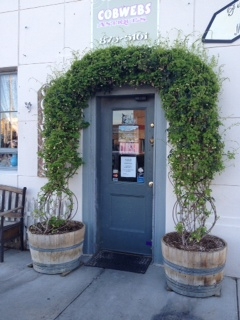If you're interested in vines or marginally edible landscape plants, you may want to check out the Akebia quinata vine at the corner of Lagoon and Main St in Bishop at Cobwebs antique shop. It is currently in bloom and appears to be the less common white-flowered type.

Akebia quinata is a fairly aggressive vine that is usually used as an ornamental. It has attractive palmately compound leaves with 5 leaflets that is the inspiration for its species name. While it's blooming (right now!) it has fragrant blossoms. To some they smell roughly like chocolate, leading some to call this plant "chocolate vine." To me it smells like a combination of freesia, privet, and hyacinth, but we all have different noses.
It is not as aggressive as wisteria, but it is no slouch, either. It is considered invasive in some eastern states, but I doubt we'd have much to worry about here in the desert. It will climb up tall trees and anything else it can find. In my opinion, akebia seems to like to grow up a lot better than sideways, unlike wisteria which will grow any which way. A great feature of akebia is that it is mostly evergreen.
Akebia will do best in Owens Valley on east and northern exposures. In my experience, it uses a fair amount of water, though nothing like a hydrangea. It tolerates shade, but if you have shade, chances are you have trees that it will like to grow up. Please don't plant this on your fence if you want to remain friends with your neighbor.
The plant itself is used in traditional Eastern medicine and apparently the fruit is edible. While sweet, it doesn't seem like something that you'd really get excited about eating. It's sort of a pulpy mass of seeds. The jelly-like mass reminds me of frog eggs in appearance.
I've not noticed the white type setting fruit. Maybe it does, but I haven't seen it. The standard purple flowered one will set some fruit, but it seems highly variable. I've noticed that the seeds germinate easily, at least east of the Rockies.
I'd suggest using it as an ornamental. Be willing to give it a haircut on occasion.